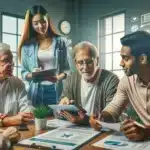For many, the thought of exercise conjures images of endorphin-fueled accomplishment. However, the reality can be a bit more… scratchy. Traditional cotton t-shirts cling to sweaty skin, chafing becomes a constant battle, and discomfort can quickly derail your workout motivation. But what if the secret to a more enjoyable and ultimately more successful training experience lay not in pushing harder but choosing smarter? Enter the world of advanced athletic fabrics designed to transform your training from a struggle to a smooth, supportive journey.

Key Takeaways:
- Understanding the impact of fabric choice on athletic performance.
- The benefits of moisture-wicking and breathable materials.
- How to choose the right training gear for different types of workouts.
- Research-backed advantages of modern sports fabrics.
- Real-life examples of athletes improving their performance with the right gear.
Table of Contents
The Role of Fabric in Athletic Performance
Regarding training, the fabric of your sportswear can be a game-changer. The right gear empowers you, enhancing performance, minimizing discomfort, and preventing injuries. But what makes sport fabric so significant in this context? It’s all about the fabric’s ability to adapt to your needs. The elasticity and durability of advanced fabrics allow you to push your limits without the constraint of uncomfortable clothing. Whether you’re sprinting, lifting weights, or practicing yoga, the suitable fabric can be your silent partner in achieving your training goals.
Breathability and Moisture-Wicking Benefits
One of the most critical factors in athletic wear is breathability. Fabrics that allow air to circulate keep you cool, especially during intense workouts. Breathable materials decrease the likelihood of overheating, ensuring you perform at your best. Additionally, moisture-wicking fabrics pull sweat away from your skin, reducing the risk of chafing and rashes. These features are crucial for long-distance runners and high-intensity interval training enthusiasts. Research has shown that maintaining a comfortable body temperature can significantly enhance performance, and moisture-wicking materials excel at this by keeping you dry.
Choosing Fabric Based on Workout Type
Not all workouts are created equal, and neither should your sportswear. For example, high-intensity workouts benefit from highly stretchable and moisture-wicking fabrics. These materials accommodate a range of motion and keep you dry, ensuring comfort. On the other hand, for yoga or pilates, softer, more flexible fabrics that allow your skin to breathe are ideal. Knowing what fabric suits your workout can enhance your comfort, allowing you to focus more on your exercises and less on adjusting your outfit.
- Running: Look for lightweight, moisture-wicking fabrics. These materials help regulate your temperature and reduce sweat buildup, which can cause chafing.
- Strength Training: Opt for durable fabrics that provide compression and support. Compression gear can improve blood flow and muscle oxygenation, leading to better performance and faster recovery.
- Yoga: Choose stretchable and breathable fabrics for better flexibility. The suitable fabric can allow you to stretch deeper into poses and move freely.
The Science Behind Modern Sports Fabrics
Athletes today benefit from years of research and technological advancements in fabric design. A study shows that moisture-wicking and breathable fabrics significantly enhance comfort and performance. Using smart textiles, fabrics that incorporate electronic components, or other advanced technologies, athletes can stay focused on their training without worrying about their gear. These fabrics are engineered to react to changes in temperature and humidity, offering a customizable wearing experience that traditional fabrics can’t match.
Real-World Examples: Athletes and Their Gear
Consider elite marathon runners like Eliud Kipchoge, the marathon world record holder, who have transitioned to using modern sports fabrics. The difference in their performance and comfort is like night and day. Kipchoge, for example, swears by the importance of the right gear, particularly his choice of moisture-wicking and breathable fabrics. Similarly, everyday athletes can benefit immensely by paying more attention to their fabric choices. Testimonials from high-profile athletes often emphasize how switching to advanced fabric technologies has helped them achieve new personal bests, reduce recovery times, and avoid injuries.
Investing in Quality: Worth Every Penny
It might be tempting to cut corners when purchasing sportswear, but investing in high-quality fabric can make a substantial difference. Quality fabrics last longer, perform better and provide unseen benefits such as UV protection and bacterial resistance. A report from the Wall Street Journal highlights numerous cases where athletes credit their performance improvements to the upgrade in their gear. Cheaper alternatives may seem like a good deal initially, but they often lack advanced features that can significantly affect your comfort and performance levels. Investing in premium sportswear is an investment in yourself and your athletic journey, giving you the confidence that you’re making the right choice.
Conclusion
When you select the fabric for your training attire, it’s essential to consider its impact on your performance and well-being. Opting for breathable, moisture-wicking, and adaptable fabrics can significantly enhance your training experience. These features can help reduce the risk of discomfort and chafing, leading to improved performance and personal achievements. Remember, the fabric you choose can make a significant difference in your workout, so always prioritize comfort and support when making your decision. When you select the fabric for your training attire, consider its impact on your performance and well-being. Opting for breathable, moisture-wicking, and adaptable fabrics can significantly enhance your training experience. These features can help reduce the risk of discomfort and chafing, leading to improved performance and personal achievements. Remember, the fabric you choose can make a significant difference in your workout, so always prioritize comfort and support when making your decision.





